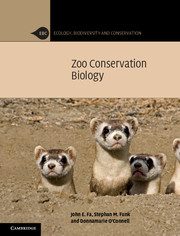Crossref Citations
This Book has been
cited by the following publications. This list is generated based on data provided by Crossref.
Pritchard, Diana J.
Fa, John E.
Oldfield, Sara
and
Harrop, Stuart R.
2012.
Bring the captive closer to the wild: redefining the role of ex situ conservation.
Oryx,
Vol. 46,
Issue. 1,
p.
18.
ESA
2012.
Books and Monographs Received.
Ecology,
Vol. 93,
Issue. 3,
p.
694.
Hunter, Luke T.B.
White, Paula
Henschel, Philipp
Frank, Laurence
Burton, Cole
Loveridge, Andrew
Balme, Guy
Breitenmoser, Christine
and
Breitenmoser, Urs
2013.
Walking with lions: why there is no role for captive-origin lions Panthera leo in species restoration.
Oryx,
Vol. 47,
Issue. 1,
p.
19.
Conde, Dalia A.
Colchero, Fernando
Gusset, Markus
Pearce-Kelly, Paul
Byers, Onnie
Flesness, Nate
Browne, Robert K.
Jones, Owen R.
and
Hayward, Matt
2013.
Zoos through the Lens of the IUCN Red List: A Global Metapopulation Approach to Support Conservation Breeding Programs.
PLoS ONE,
Vol. 8,
Issue. 12,
p.
e80311.
Reid, G. McG.
Contreras MacBeath, T.
and
Csatádi, K.
2013.
Global challenges in freshwater‐fish conservation related to public aquariums and the aquarium industry.
International Zoo Yearbook,
Vol. 47,
Issue. 1,
p.
6.
Chargé, Rémi
Teplitsky, Céline
Sorci, Gabriele
and
Low, Matthew
2014.
Can sexual selection theory inform genetic management of captive populations? A review.
Evolutionary Applications,
Vol. 7,
Issue. 9,
p.
1120.
Roe, Katie
McConney, Andrew
and
Mansfield, Caroline F.
2014.
The Role of Zoos in Modern Society—A Comparison of Zoos' Reported Priorities and What Visitors Believe They Should Be.
Anthrozoös,
Vol. 27,
Issue. 4,
p.
529.
Martin, T. E.
Lurbiecki, H.
and
Mooers, A. O.
2014.
The economic geography of ex situ
conservation.
Animal Conservation,
Vol. 17,
Issue. 2,
p.
104.
Fa, J. E.
Gusset, M.
Flesness, N.
and
Conde, D. A.
2014.
Zoos have yet to unveil their full conservation potential.
Animal Conservation,
Vol. 17,
Issue. 2,
p.
97.
Gusset, Markus
Fa, John E.
and
Sutherland, William J.
2014.
A horizon scan for species conservation by zoos and aquariums.
Zoo Biology,
Vol. 33,
Issue. 5,
p.
375.
Rose, P. E.
Croft, D. P.
and
Lee, R.
2014.
A review of captive flamingo (Phoenicopteridae) welfare: a synthesis of current knowledge and future directions.
International Zoo Yearbook,
Vol. 48,
Issue. 1,
p.
139.
Schulte‐Hostedde, Albrecht I.
and
Mastromonaco, Gabriela F.
2015.
Integrating evolution in the management of captive zoo populations.
Evolutionary Applications,
Vol. 8,
Issue. 5,
p.
413.
Frankham, Richard
2015.
Genetic rescue of small inbred populations: meta‐analysis reveals large and consistent benefits of gene flow.
Molecular Ecology,
Vol. 24,
Issue. 11,
p.
2610.
Rinkevich, Baruch
2015.
Climate Change and Active Reef Restoration—Ways of Constructing the “Reefs of Tomorrow”.
Journal of Marine Science and Engineering,
Vol. 3,
Issue. 1,
p.
111.
Keulartz, Jozef
2016.
Should the Lion Eat Straw Like the Ox? Animal Ethics and the Predation Problem.
Journal of Agricultural and Environmental Ethics,
Vol. 29,
Issue. 5,
p.
813.
Martín, Olga
Vinyoles, Dolors
García-Galea, Eduardo
and
Maté, Carmen
2016.
Improving the Welfare of a Zoo-Housed Male Drill (Mandrillus leucophaeus poensis) Aggressive Toward Visitors.
Journal of Applied Animal Welfare Science,
Vol. 19,
Issue. 4,
p.
323.
Bennett, Allyson J.
and
Panicker, Sangeeta
2016.
Broader impacts: international implications and integrative ethical consideration of policy decisions about US chimpanzee research.
American Journal of Primatology,
Vol. 78,
Issue. 12,
p.
1282.
Dawson, Jeff
Patel, Freisha
Griffiths, Richard A.
and
Young, Richard P.
2016.
Assessing the global zoo response to the amphibian crisis through 20‐year trends in captive collections.
Conservation Biology,
Vol. 30,
Issue. 1,
p.
82.
Oldfield, Sara
and
Kapos, Valerie
2017.
Plant Conservation Science and Practice.
p.
219.
Funk, Stephan M.
Conde, Dalia
Lamoreux, John
and
Fa, Julia E.
2017.
Meeting the Aichi targets: Pushing for zero extinction conservation.
Ambio,
Vol. 46,
Issue. 4,
p.
443.



